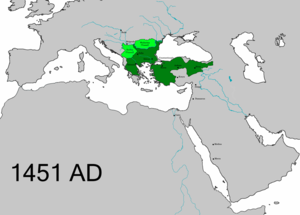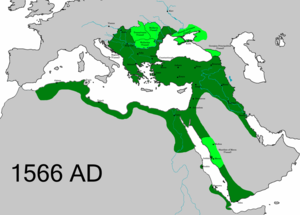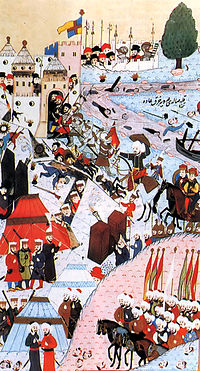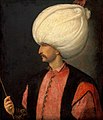Classical Age of the Ottoman Empire
| History of the Ottoman Empire |
|---|
 |
| Timeline |
| Historiography (Ghaza, Decline) |
The Classical Age of the Ottoman Empire (
Territory


The Ottoman Empire of the Classical Age experienced dramatic territorial growth. The period opened with the
The reign of
Rapid expansion resumed under
Expansion continued during the first half of the reign of Suleiman I (r. 1520–1566), who conquered first Belgrade (1521) and Rhodes, before invading Hungary in 1526, defeating and killing King Louis II in the Battle of Mohács and briefly occupying Buda. Lacking a king, Hungary descended into civil war over the succession, and the Ottomans gave support to John Zápolya as a vassal prince. When their rivals the Habsburgs began to achieve the upper hand, Suleiman directly intervened by again conquering Buda and annexing it to the empire in 1541. Elsewhere, Suleiman led major campaigns against Safavid Iran, conquering Baghdad in 1534 and annexing Iraq. Ottoman rule was further extended with the incorporation of much of North Africa, the conquest of coastal Yemen in 1538, and the subsequent annexation of the interior.
After the annexation of
Political history
1451–1481: Mehmed II
The
Another important political entity which shaped the Eastern policy of Mehmed II was the
After the Fall of Constantinople, Mehmed would also go on to conquer the



Mehmed II advanced toward
In 1463, after a dispute over the tribute paid annually by the
In 1462 Mehmed II came into conflict with Prince
In 1475, the Ottomans suffered a great defeat at the hands of Stephen the Great of Moldavia at the Battle of Vaslui. In 1476, Mehmed won a pyrrhic victory against Stephen at the Battle of Valea Albă. He besieged the capital of Suceava, but could not take it, nor could he take the Castle of Târgu Neamț. With a plague running in his camp and food and water being very scarce, Mehmed was forced to retreat.
Mehmed II invaded
1481–1512: Bayezid II
When Bayezid II was enthroned upon his father's death in 1481, he first had to fight his younger brother
Sultan Bayezid attacked
Later that year, Bayezid's son Ahmet forced his father into making him regent. His brother Selim was forced to flee to Crimea. When Ahmet was about to be crowned, the Janissaries intervened, killed the prince and forced Bayezid into calling Selim back and making him the sultan. Bayezid abdicated, and he died immediately after leaving the throne.
1512–1520: Selim I
During his reign,
1520–1566: Suleiman the Magnificent
), a territory which temporarily fixed the border between the Habsburgs and the Ottomans.The
Huge territories of North Africa up to west of Algeria were annexed. The

Ottoman navies also controlled the
In 1535 the Habsburg Holy Roman Emperor, Charles V (Charles I of Spain) won an important victory against the Ottomans at Tunis, but in 1536 King Francis I of France allied himself with Suleiman against Charles. In 1538, the fleet of Charles V was defeated at the Battle of Preveza by Khair ad Din, securing the eastern Mediterranean for the Turks for 33 years. Francis I asked for help from Suleiman, then sent a fleet headed by Khair ad Din who was victorious over the Spaniards, and managed to retake Naples from them. Suleiman bestowed on him the title of beylerbey. One result of the alliance was the fierce sea duel between Dragut and Andrea Doria, which left the northern Mediterranean and the southern Mediterranean in Ottoman's hands.
Gallery
-
Mehmed II
-
Bayezid II
-
Selim I
-
Suleiman I
See also
References
- ISBN 978-1-107-03442-6.
- ^ Heywood, Colin (2009). "Mehmed II". In Ágoston, Gábor; Bruce Masters (eds.). Encyclopedia of the Ottoman Empire. pp. 364–8.
- ^ Ágoston, Gábor (2009). "Bayezid II". In Ágoston, Gábor; Bruce Masters (eds.). Encyclopedia of the Ottoman Empire. pp. 82–4.
- ^ Ágoston, Gábor (2009). "Selim I". In Ágoston, Gábor; Bruce Masters (eds.). Encyclopedia of the Ottoman Empire. pp. 511–3.
- ^ Ágoston, Gábor (2009). "Süleyman I". In Ágoston, Gábor; Bruce Masters (eds.). Encyclopedia of the Ottoman Empire. pp. 541–7.
- ^ "The young Dracula environment and education". Archived from the original on 2009-06-24. Retrieved 2012-07-03.
- ^ Mehmed the Conqueror and his time pp. 204–5
- ^ Dracula: Prince of many faces: His life and his times p. 147
- ^ LCCN 2020046920.
- OCLC 617914.
- ^ Alan Mikhail, God's Shadow: Sultan Selim, His Ottoman Empire, and the Making of the Modern World (2020) excerpt
- ^ Max Scherberger, “The Confrontation between Sunni and Shi’i Empires: Ottoman-Safavid Relations between the Fourteenth and the Seventeenth Centuries” in The Sunna and Shi'a in History: Division and Ecumenism in the Muslim Middle East ed. by Ofra Bengio & Meir Litvak (New York: Palgrave Macmillan, 2011) (“Scherberger”), pp. 59-60.
- ^ Mikheil Svanidze, “The Amasya Peace Treaty between the Ottoman Empire and Iran (June 1, 1555) and Georgia,” Bulletin of the Georgian National Academy of Sciences, vol. 3, no. 1, pp. 191-97 (2009) (“Svanidze”), p. 192.
- ^ Svandze, pp. 193-94.
- ^ Douglas E. Streusand, ‘’Islamic Gunpowder Empires: Ottomans, Safavids, and Mughals (Boulder, Colo.: Westview Press, c. 2011), p. 50.
- ^ Scherberger, p. 60.
Further reading
Surveys
- Howard, Douglas A. (2017). A History of the Ottoman Empire. Cambridge: Cambridge University Press. ISBN 978-0-521-72730-3.
- Finkel, Caroline (2005). Osman's Dream: The Story of the Ottoman Empire, 1300-1923. Basic Books. ISBN 978-0-465-02396-7.
- Hathaway, Jane (2008). The Arab Lands under Ottoman Rule, 1516-1800. Pearson Education Ltd. p. 8. ISBN 978-0-582-41899-8.
- ISBN 978-1-1370-1406-1.
- İnalcık, Halil; Donald Quataert, eds. (1994). An Economic and Social History of the Ottoman Empire, 1300-1914. Vol. 1. Cambridge University Press. ISBN 0-521-57456-0.
- Mikhail, Alan. God's Shadow: Sultan Selim, His Ottoman Empire, and the Making of the Modern World (2020) excerpt on Selim I
Suleiman the Magnificent (r. 1520-1566)
- İnalcık; Cemal Kafadar, Halil, eds. (1993). Süleyman the Second [i.e. the First] and His Time. Istanbul: The Isis Press. ISBN 975-428-052-5.
- Şahin, Kaya (2013). Empire and Power in the Reign of Süleyman: Narrating the Sixteenth-Century Ottoman World. Cambridge University Press. ISBN 978-1-107-03442-6.




